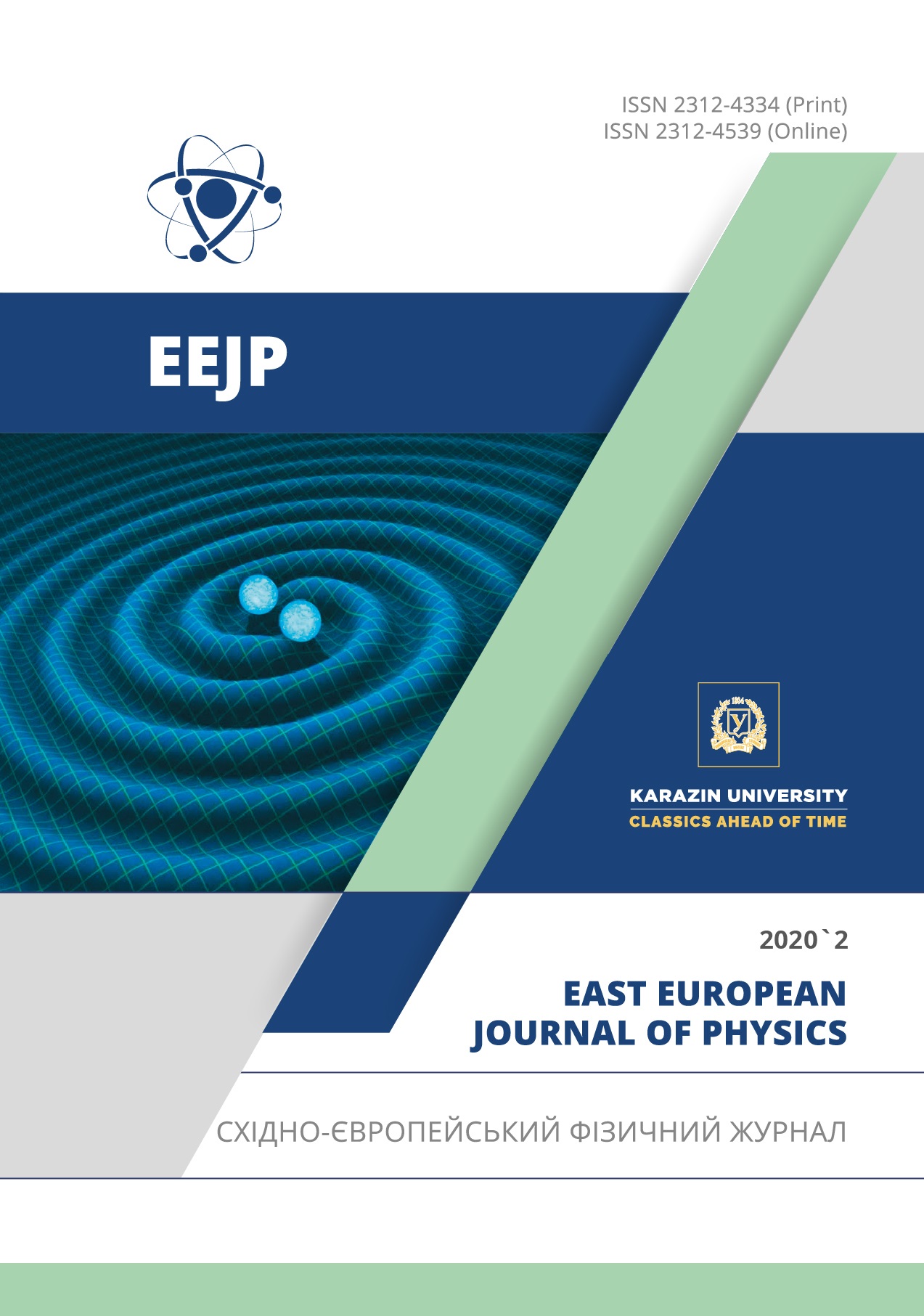Nonlinear Effects in the Phonon System of Diamond Crystal
Abstract
Thermodynamic properties of diamond are theoretically investigated on the ground of self-consistent description of a phonon gas in lattice, which generalizes the Debye model with taking into account the phonon-phonon interaction. In many cases properties of crystals of certain symmetry can be well approximated by a model of an isotropic continuous medium, if its elastic moduli are chosen optimally. They should be found for a crystal of each symmetry from the condition of their proximity to the exact elastic moduli, which are measured experimentally and are given in the corresponding tables. At high temperatures, the nonlinear phonon interaction takes into account both three- and four-phonon interactions. In this reason we take into account not only the second-order elastic moduli tensor in the reduced isotropic crystal model, but also the third- and fourth-order elastic moduli tensors, which are all together characterized by nine independent components. Account of the phonon-phonon interaction leads to the redefinition of the phonon’s speed and of the Debye energy. Their dependence on the temperature occurs. In the absence of interaction and neglecting the nonlinear effects, the phonons are the same as that of the Debye model. They are called "bare" or "Debye". Phonons whose speed is renormalized due to the interaction are called the “self-consistent” ones. It is shown that, at high temperatures, the theory predicts the linear in the temperature deviation of the isochoric heat capacity from the Dulong-Petit law. Unlike for the most crystals, where the decrease in the isochoric heat capacity is observed, our calculations for diamond and crystals with diamond structure predict the linear increase of the isochoric heat capacity with the temperature, viewed experimentally. The isobaric heat capacity of diamond, similar to other substances, linearly increases with the temperature.
Downloads
References
L.D. Landau, and E.M. Lifshitz, Statistical physics. Part 1, 3rd ed., (Elsevier Science & Technology, 1980).
Yu.M. Poluektov, Low Temperature Physics, 41, 922 (2015). https://doi.org/10.1063/1.4936228.
Yu.M. Poluektov, East European Journal of Physics, 3, 35-46 (2016), https://doi.org/10.26565/2312-4334-2016-3-03.
F.I. Fedorov, Theory of Elastic Waves in Crystals, (Plenum Press, New York, 1968).
A.I. Akhiezer, V.F. Aleksin, and V.D. Khodusov, Low Temp. Phys. 20, 939-970 (1994).
P.B. Ghate, Journal of Applied Physics, 35, 337 (1964), https://doi.org/10.1063/1.1713312.
H. Wang, and M. Li, Phys. Rew. B, 79, (2009) 224102, https://doi.org/10.1103/PhysRevB.79.224102.
M. Destrade, and R.W. Ogden, The Journal of the Acoustical Society of America, 128 3334 (2010). https://doi.org/10.1121/1.3505102.
O. Burlayenko, V. Khodusov, and A. Naumovets, East Eur. J. Phys. 5, 70-73 (2018), https://doi.org/10.26565/2312-4334-2018-1-08.
C. Kittel, Introduction to Solid State Physics, 8th ed., (John Wiley and Sons LTD, 2004).
S.Sh. Rekhviashvili, and Kh.L. Kunizhev, High Temperature, 55, 312–314 (2017). https://doi.org/10.1134/S0018151X17020146.
Yu.M. Poluektov, Russian Physics Journal, 47, 74-79 (2004), https://doi.org/10.1023/B:RUPJ.0000047847.43927.41.
Yu.M. Poluektov, Russian Physics Journal, 52, 30-40 (2009), https://doi.org/10.1007/s11182-009-9202-y.
V.Yu. Bodryakov, and A.A. Povzner, Physics of the Solid State, 47, 1196-1200 (2003).
V.Yu. Bodryakov, Solid Stat. Comm. 83, 1053-1055 (1994).
V.A. Oskina, A.A. Povzner, A.N. Filanovich, A.G. Volkov, N.A. Zaytseva, T.A. Nogovitsyna, L.R. Kabirova, and K.A. Shumikhina, Fundamental Research, 8, 73-76 (2013).
A.A. Povzner, A.G. Volkov, and A.N. Filanovich, Physics of the Solid State, 53, 1673-1678 (2011).
L.D. Landau, L.P. Pitaevskii, A.M. Kosevich, and E.M. Lifshitz, Theory of Elasticity, 3rd ed., (Butterworth-Heinemann, 2012).
Yu.M. Poluektov, Ukr. J. Phys., 50, 1237 (2005), https://arxiv.org/abs/1303.4913.
Yu.M. Poluektov, Low Temperature Physics, 28, 429-441 (2002), https://doi.org/10.1063/1.1491184.
Yu.M. Poluektov, Ukr. J. Phys., 52, 579 (2007). https://arxiv.org/abs/1306.2103.
Y.M. Poluektov, Russian physics journal, 47, 656-663 (2004), https://doi.org/10.1023/B:RUPJ.0000047847.43927.41.
Y.M. Poluektov, Russian physics journal, 52, 33-45 (2009), https://doi.org/10.1007/s11182-009-9202-y.
J. M. Ziman, Principles of the Theory of Solids, 2nd edition, (Cambridge Univ. Press, 1972).
J.A. Reissland, The Physics of Phonons. (London, John Wiley and Sons LTD., London; New York; Sydney; Toronto, 1973).
D. Gerlich, Journal of Applied Physics, 77, 4373-4379 (1995), https://doi.org/10.1063/1.359462.
A.V. Telichko, S.V. Erohin, G.M. Kvashnin, P.B. Sorokin, B.P. Sorokin, and V.D. Blank, J. Mater. Sci. 52, 3447 (2017). https://doi.org/10.1007/s10853-016-0633-x.
Yu.M. Poluektov, East Eur. J. Phys. 5, 4-12 (2018)б https://doi.org/10.26565/2312-4334-2018-3-01.
K. Wang, and R.R. Reeber, Phys. Chem. Minerals. 23, 354-360 (1996), https://doi.org/10.1007/BF00199501.
R.R. Reeber, and K. Wang, Journal of Electronic Materials, 25, 63-67 (1996), https://doi.org/10.1007/BF02666175.
A.C. Victor, The Journal of Chemical Physics, 36, 1903 (1962), https://doi.org/10.1063/1.1701288.
Authors who publish with this journal agree to the following terms:
- Authors retain copyright and grant the journal right of first publication with the work simultaneously licensed under a Creative Commons Attribution License that allows others to share the work with an acknowledgment of the work's authorship and initial publication in this journal.
- Authors are able to enter into separate, additional contractual arrangements for the non-exclusive distribution of the journal's published version of the work (e.g., post it to an institutional repository or publish it in a book), with an acknowledgment of its initial publication in this journal.
- Authors are permitted and encouraged to post their work online (e.g., in institutional repositories or on their website) prior to and during the submission process, as it can lead to productive exchanges, as well as earlier and greater citation of published work (See The Effect of Open Access).








